Pickle Sourdough Rye Bread Recipe
This post may contain affiliate links.
Pickle Sourdough Rye Bread is a tasty recipe perfect for lovers of dill cucumbers pickles.
A rustic sourdough bread with a unique flavor profile.
It's a little salty, a little sweet and more than a little lovely.
Pickle sourdough rye bread makes the most amazing grilled cheese sandwiches. It's perfect for eating on its own too. But even better with cold cuts! And cheese, did I mention cheese?
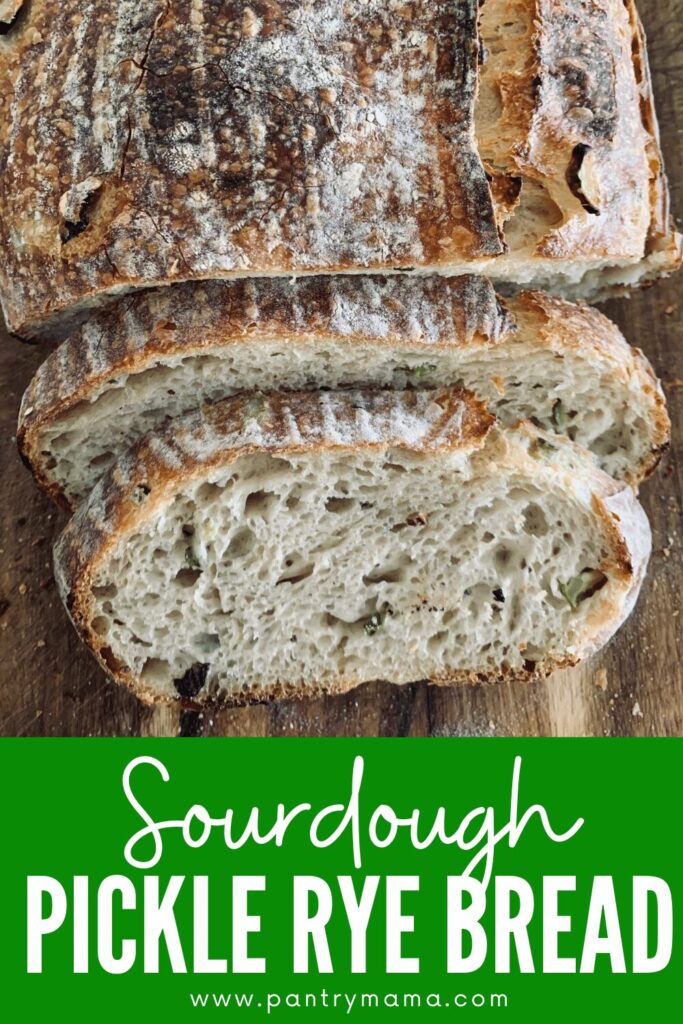
Which Pickles to Use?
I use whole cucumber dill pickles which I dice up to make this sourdough bread.
You can use whatever pickles you like, but I find that the dill cucumber pickles give the best result. Using whole ones mean that you can slice them however you'd like them to be in your bread.
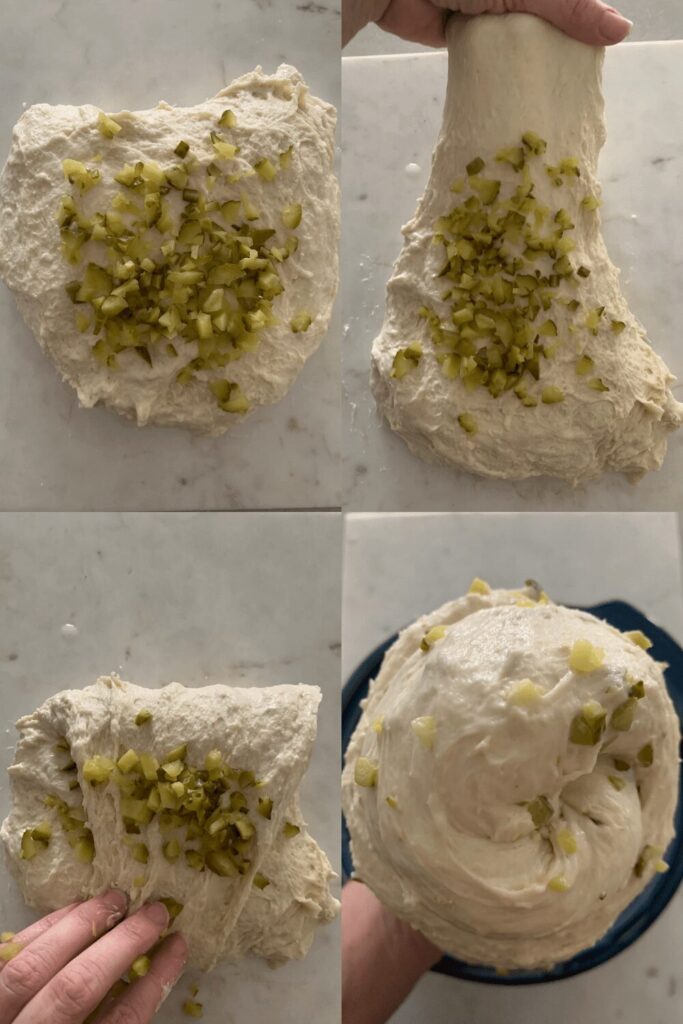
You could even add some of the dill from the jar in your sourdough if you like. Just be sure to dice it finely so you don't get big clumps of it in your sourdough.
The sugars in the pickle juice, combined with the whole wheat and rye in this recipe give you the crunchiest crust - it's just lovely! If you have lots of dill pickles to use up, you might also enjoy this sourdough dill pickle cheddar focaccia bread recipe.
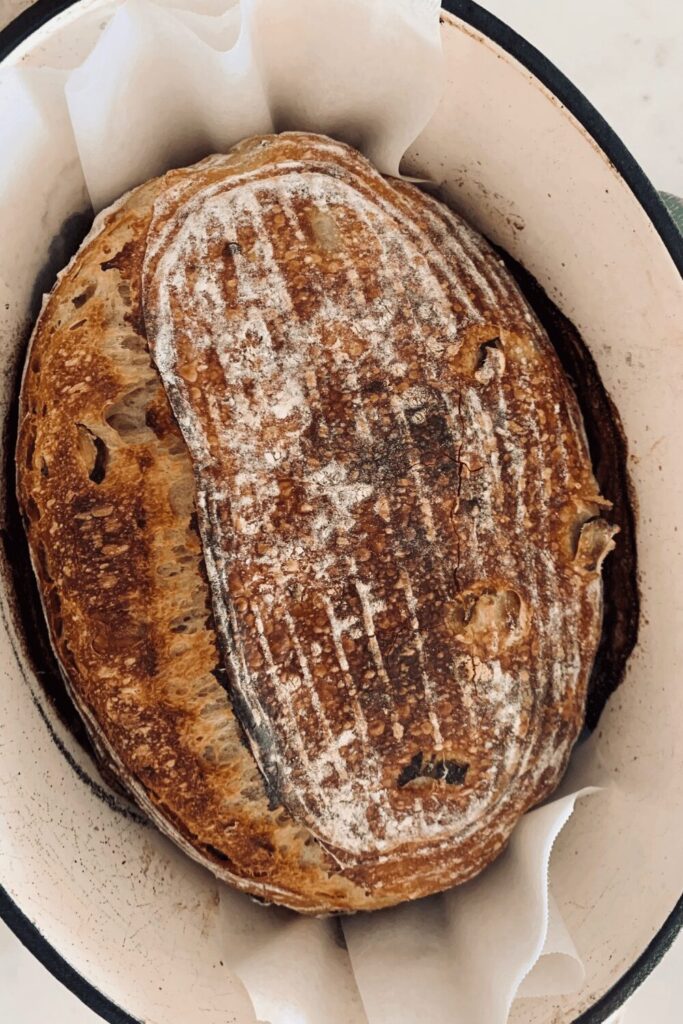
Flour Substitutions for Pickle Sourdough Rye Bread
This recipe features both rye and whole wheat flours blended with bread flour to give maximum flavor and texture.
You can however change the flour mix to suit your taste and skill level.
Here are some suggestions:
- You can bake sourdough pickle bread with only bread flour - just reduce the water content to 150g (so it would have 350g of liquid overall including the pickle juice).
- You can use up to 250g of whole wheat (instead of 250g of bread flour). For more information on using whole wheat, this page is helpful.
- You can use more than 100g of rye however this will change the dough and you may find it harder to handle. It's harder to get oven spring if you use more than 20% rye.
If you're looking for a true rye flavor, try this rustic sourdough rye bread.

Will It Be Too Salty?
Sourdough Dill Pickle Bread is not overly salty, despite adding the pickle juice as the liquid in your dough.
If you don't like a really salty loaf, you could choose not to add the additional salt listed in the recipe, however I don't feel that it's too salty at all.
But you can certainly adjust this to suit your tastebuds.
Want some other ideas for things to add to your sourdough bread? Check out all of these ideas!
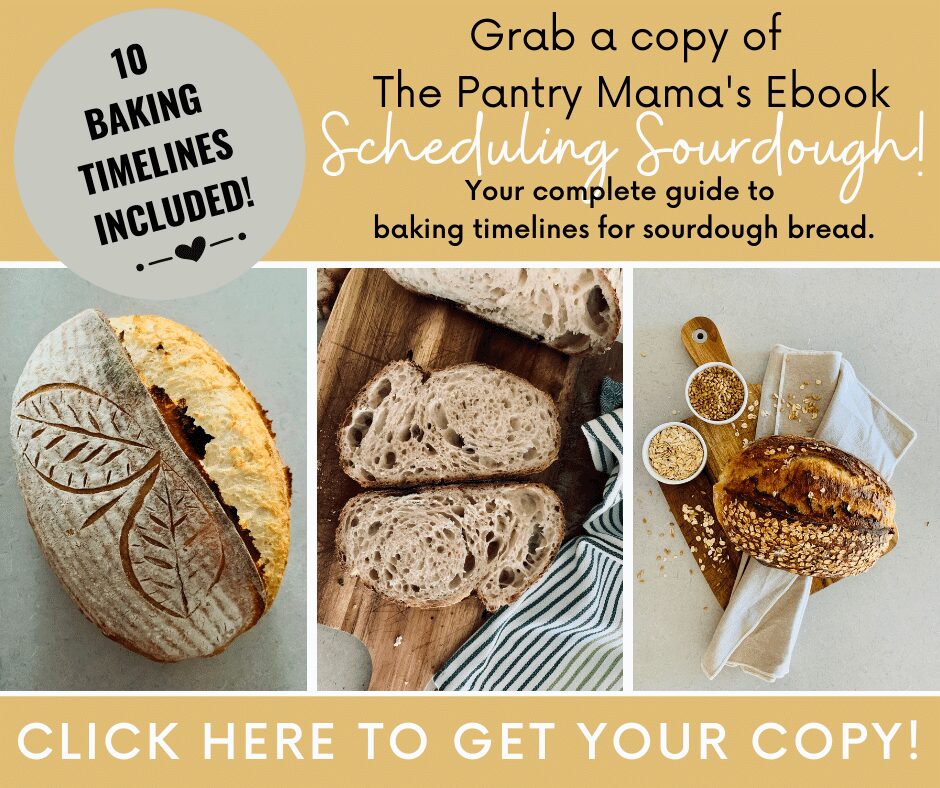
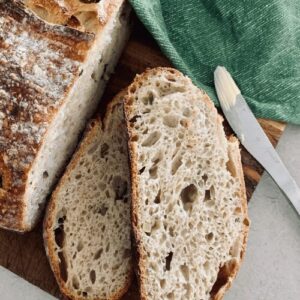
Pickle Sourdough Rye Bread Recipe
Equipment
- Mixing Bowl
- Banneton
- Dutch Oven
Ingredients
- 200 g Pickle Juice
- 170 g Water
- 50 g Active Sourdough Starter
- 350 g Bread Flour
- 50 g Whole Wheat Flour
- 100 g Rye Flour
- 3 g Salt
- 150 g Finely diced dill pickles
Instructions
- Autolyse / Premix: Weigh out your starter, water, pickle juice, flour and salt and mix altogether with the end of a wooden spoon. The dough will be fairly shaggy and only just brought together.Cover your bowl with cling film or a damp tea towel and let it sit for around 1 hour.
- Forming Up Your Dough: Work your way around the bowl, grabbing the dough from the outside, stretching it up and over itself until a smooth ball is formed. You shouldn't need more than about 20-25 folds to form the ball.Once the dough has formed into a smooth ball, pop the cling film back on and let it rest for 30 minutes.
- Stretch & Fold (Creating Structure): You need to add the diced dill pickles to your dough during the stretch and fold phase. It's very easy to do! Try to add the diced dill pickles around the second or third set of stretch and folds. So do your first set of stretch and folds with the dough as is and then add the pickles on the second (or third) set depending on how your dough is behaving. Try to do around 4 sets of stretch and folds with around 15 to 30 minutes between each set.It's up to you whether you want to do these in the bowl (less messy) or take your dough out onto your bench top and do it there. Do whatever you're more comfortable with.

- Bulk Ferment: Once you've finished your stretch and folds, place the cling film or damp tea towel back over your dough and let it rest and ferment. The time this takes will depend on the temperature in your home (see recipe notes for more information).

- Shaping Your Dough: Once your dough has finished its first ferment, it's time to give it some shape and surface tension. I think this recipe lends itself to a batard however it's completely up to you what shape you would like. Place your shaped sourdough into a banneton or other shaping container.

- Cold Ferment: Now your dough is in it's "shaping container" cover it loosely with a plastic bag or damp tea towel and place into the fridge. I use a large plastic bag to cover it - I just reuse it each time.Try to leave it in the fridge for a minimum 5 hours up to a maximum of around 36 hours. The longer you leave it the better your bread will be!

- Preparing to Bake: Once you're ready to bake your sourdough, you'll need to preheat your oven to 230C/450F. Place your Dutch Oven into the oven when you turn it on so it gets hot. Try to preheat for around 1 hour to ensure your oven is super hot - but you know your oven so just adjust this time if you need to.Leave your dough in the fridge until the very last minute - placing a cold dough into a hot oven will give you a great oven spring.
- Baking Your Pickle Sourdough: Now it's time to bake! When your oven is at temperature. Take your sourdough out of the fridge. Gently place it onto a piece of baking paper.Gently score your bread with a lame, clean razor blade or knife. Carefully take your dutch oven out of the oven. Place the sourdough into the pot using the baking paper as a handle. Put the lid on and place into the hot oven. If you want to you can spritz your dough with extra water before you put the lid on.BAKE TIME:30 Minutes with the lid on at 230C/450F plus10-15 Minutes with the lid off at 210C/410F
- Finishing Your Bake: When you remove your dough from the oven, carefully remove it from the dutch oven as soon as possible and place on a wire rack to cool.

Notes
- Notes on Sourdough Starter
This recipe is based on you having an active starter that you have fed a few hours before starting your bake. For information on whether your starter is ready, go here. - Notes on Stretch & Folds
If you are going to do the stretch & folds on your bench top, spray your surface with water mist rather than using flour. This dough can be quite wet because of the rye and the moisture from the dill pickles, but it should still workable. - Notes on Bulk Fermentation:
If your home is warm then your dough will ferment a lot faster and could be done in as little as a few hours. If it's colder, it will take longer, possibly overnight. I would recommend that you try to do your first few bulk ferments during daylight hours so that you can watch your dough closely.
Once you're more familiar with the process - and the temperature of your home - you will be able to do overnight ferments.
You will know your dough is ready to move to the next stage when it has *just* doubled in size. It will be fairly wobbly and full of bubbles. You should be able to see large air bubbles under the surface of the dough.
You don't want to let it go any further than doubled as it will be over fermented. If you want to do an overnight ferment, but your home is warm, consider using a little less starter (ie 25g).
Less starter means your dough will take longer to ferment and you will reduce the risk of over fermenting your dough.
You'll find more information on these topics here:
When is my bulk ferment finished? What is the difference between cold ferment and bulk ferment? Why does the amount of starter matter? - Notes on Baking
If you're worried about the base of your bread burning, place a baking sheet on shelf underneath your Dutch Oven - it works! If you're worried about your bread not being cooked all the way through, turn the oven off and place your dough straight onto the oven rack.
Leave the door ajar and let your bread rest there for a few hours.
Remember not to cut into your loaf too soon - you'll need to let it cool for at least a few hours (4-6 is best).
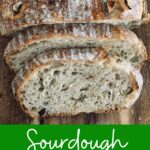
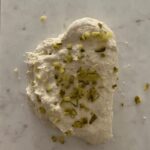
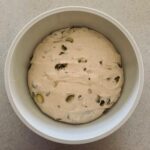
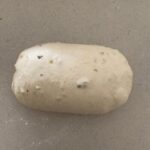
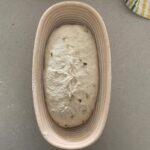
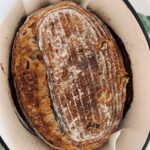
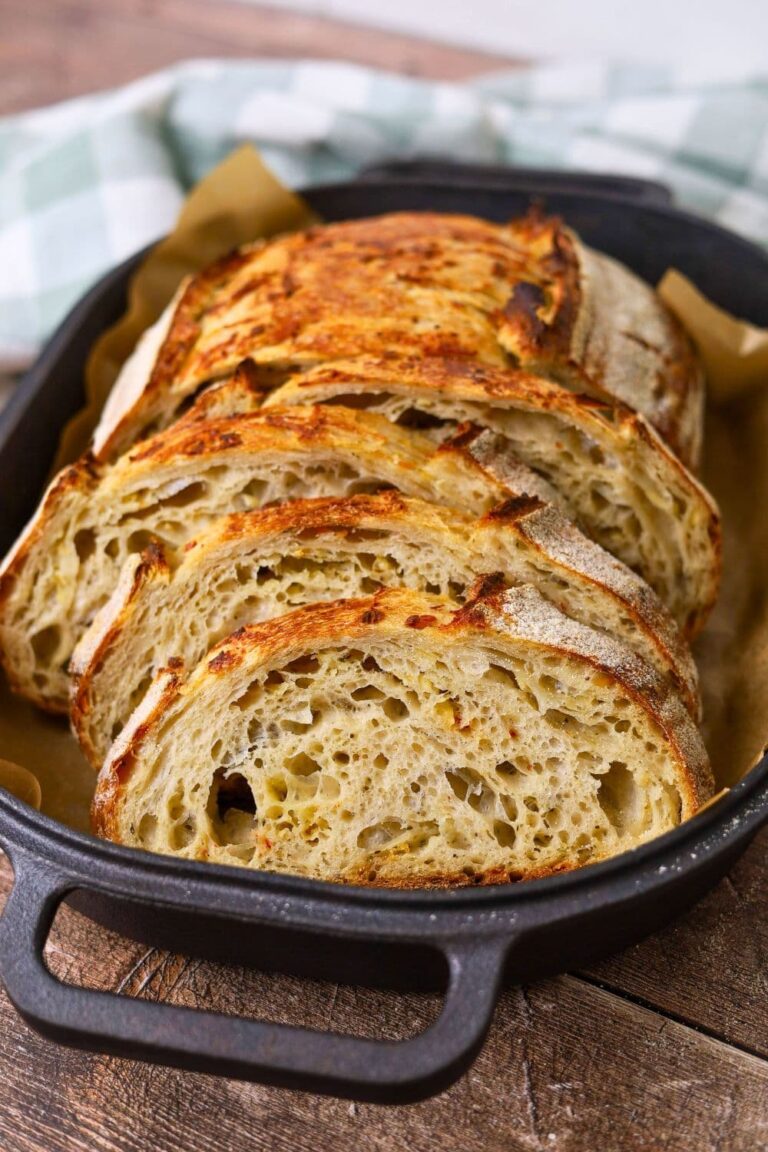
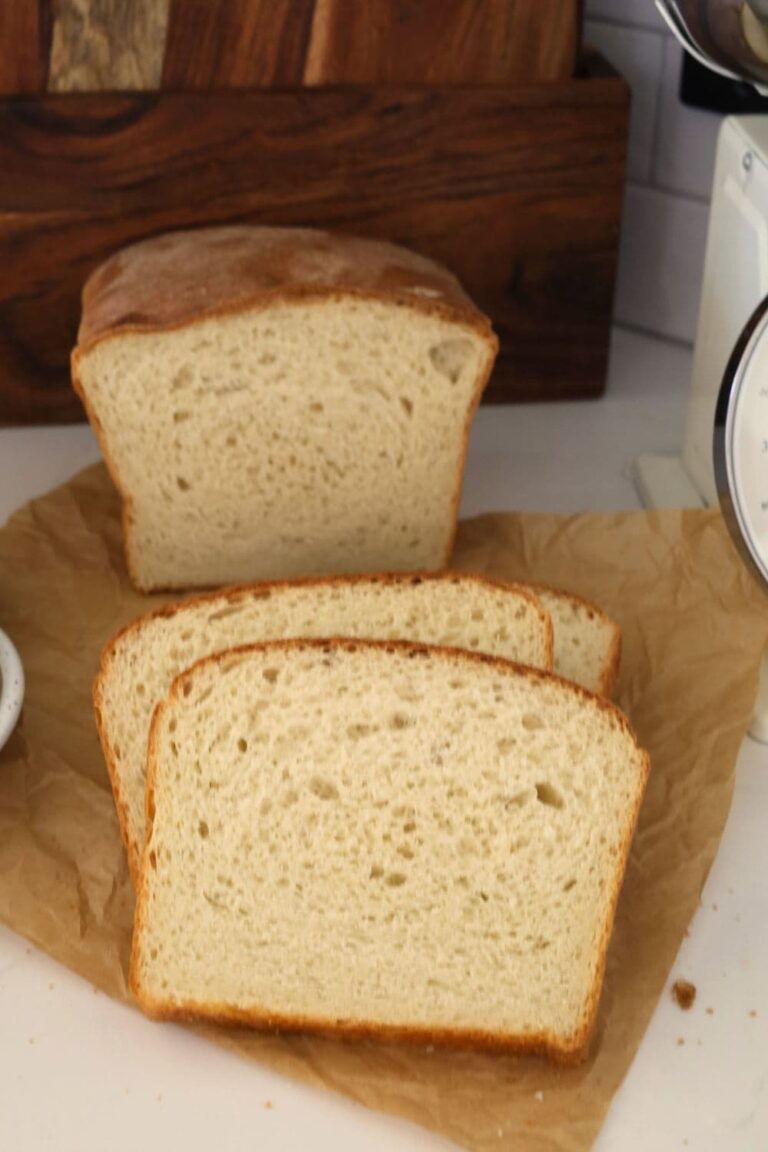
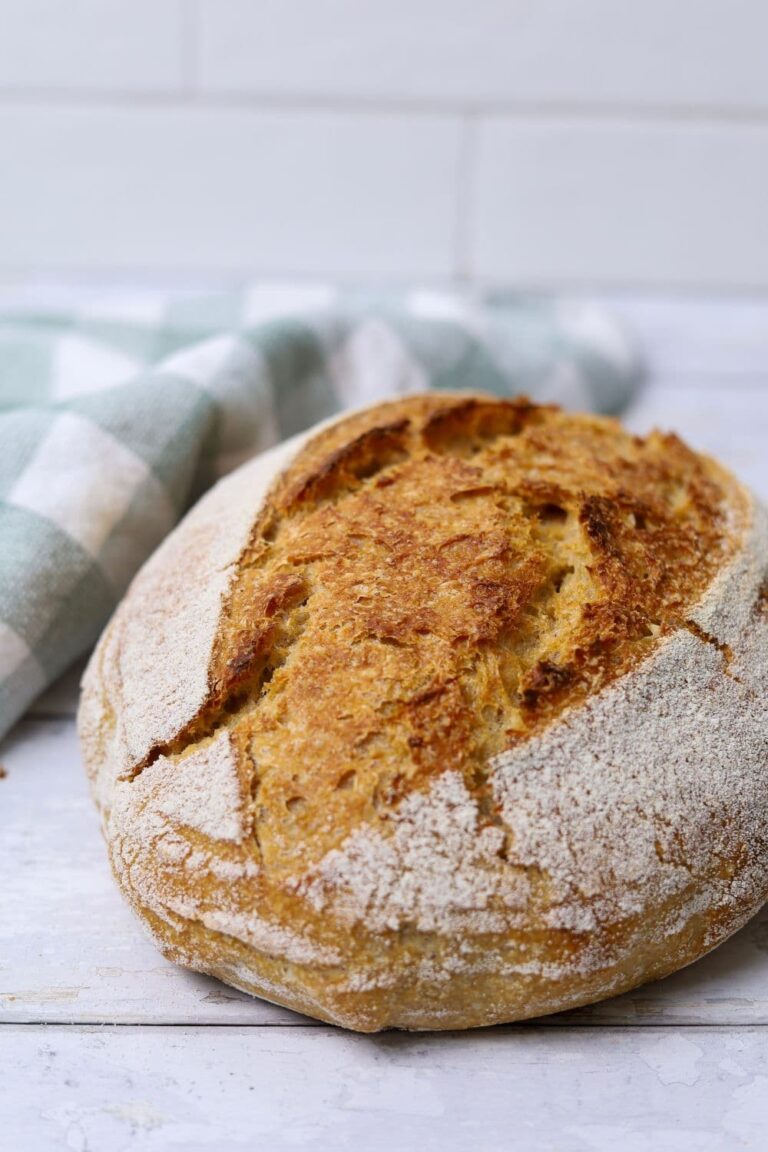
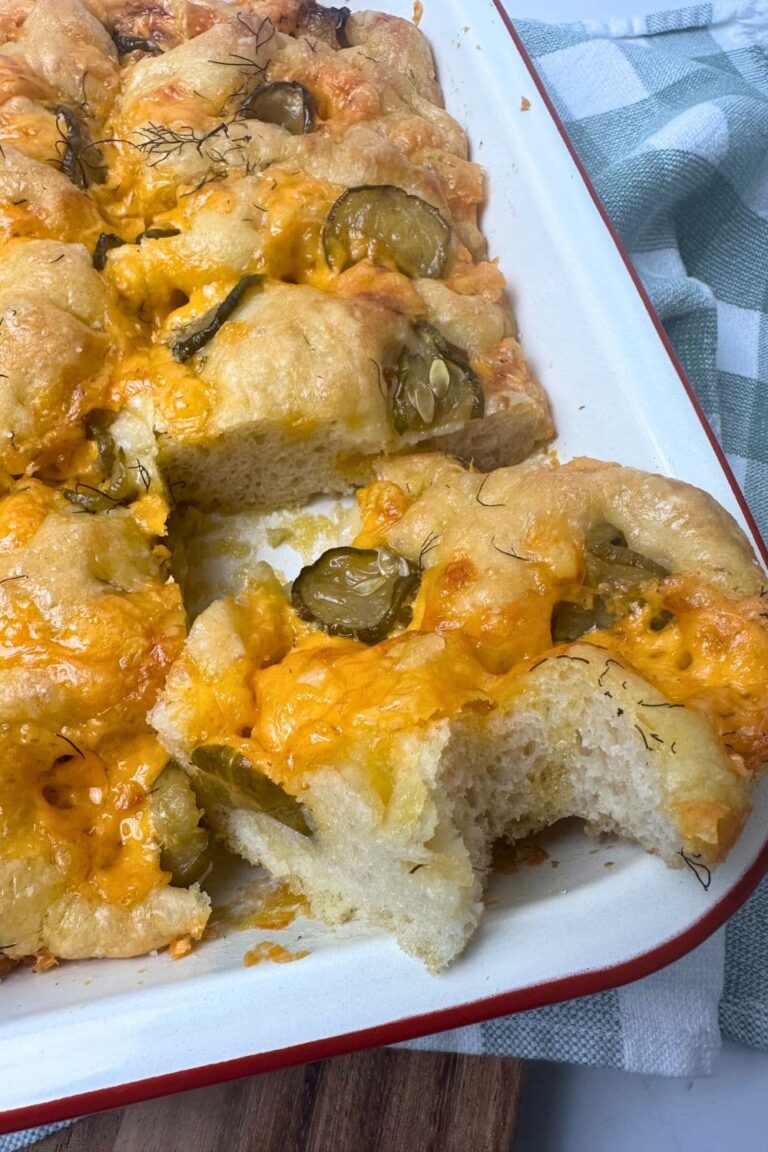

When I began to add the finely diced pickles during stretch and fold, they created liquid which made the dough wetter. I thoroughly dried the pickles that I had left when I realized what was happening, but not sure how well this loaf is going to turn out. I would definitely suggest thorough drying of the diced pickles, though. (All of my measurements were done accurately, with a scale, etc.).
I made this bread and it tastes wonderful, but it was a "fail." The dough seemed like it was coming along well until I added the diced pickles. Adding the pickles made the dough very wet and I lost the dough strength. I used store bought pickles from a jar. How should I have resolved the situation? Should I have added more flour after adding the pickles? I put the dough in a loaf pan and baked it.
Thank you.
This loaf is absolutely amazing. The pickle juice gave the bread such a zing. Light and fluffy crumb with the perfect undertones of rye with a hint of wheat. My husband who turned his nose up the thought of a pickle bread is devouring the whole thing. First time I ever had success making any kind of rye bread.
Thank you
I see you were very happy with your bake...I don't know how mine will turn out. It is currently in the fridge. It was soooo wet. I could not really shape it. I have had a hard time with rye bread being wet before. I could not actually shape this bread at all...could not stand in a shape on its own as was pictured. I drained the juice from the chopped pickles well before adding. I have been making pickles this Spring and my family loves them...I thought this would be a nice surprise. I have a feeling that I will be the one surprised when I try to bake this!!
Any info from you would be a help.
thankyou!
How do I adjust this recipe to omit the chopped pickles?
Instead of adjusting this recipe, you could try this sourdough rye bread instead 🙂
I have only recently started baking sourdough bread. I put my starter in a clean pickle jar that still has the smell of pickle in it. My daughter said wow, I bet a pickle bread would be good! . I did a quick search and found your Pickle Sourdough Rye Bread Recipe. I was thrilled! I followed your recipe and instructions and it turned out amazing! My daughter came over and was able to have some right when it was cool enough to slice. We absolutely love the way it tasted! My husband and my neighbors enjoyed it as well!
I can't wait to make it again and make rueben sandwiches!
Questions: (1) Why is this labeled as autolyse, when the salt is immediately introduced? My way of making sourdough is to first combine the flour, water, and starter. (In this case, pickle juice also.) This will make for far fewer folds.
After allowing the dough to rest for 20 minutes, then introduce the salt. Then, do three folds one hour apart, introducing the diced pickle on the second of the three folds (or third). Refrigerate overnight and bake as described. This is my approach when using minced garlic, and it always turns out great. What's your opinion on doing it that way? (2) The instructions explain how to adjust when you only want to use bread flour, but how do you adjust by grams when you want only bread flour and rye flour?
I am now in the process of making this, but doing it my way. That’s introducing the salt 20 minutes in, then letting it sit an hour. There will just be three folds one hour apart, and I’ll introduce the diced pickle on the second fold. So, we’ll see what happens.
Could I add cheddar cheese to the recipe?
Ooohhh yes! Dill pickle and cheddar cheese sourdough would be amazing!
Thank you! I made it all with white flour and added in 130g of shredded old cheddar cheese and it’s so good! I love it toasted with some cream cheese. Even on its own it’s just 😘👌
The dough was sticky after bulk ferment making it impossible to get any tension. It is in the banneton in the refrigerator now. Will it be ok? Or did I ruin it?
Thank you for this and making it today! Can I add like 15 grams of Caraway seeds to give more of a rye taste?
I am in the process of making this pickle bread, and also the olive bread. It seems as if most of your breads (at least the ones I have already made) use 100 grams of starter, but these 2 recipes call for only 50 grams. Can you explain WHY please? I understand that you can adjust bulk fermenting time with starter quantity, but I wondered if there was another reason? Since these both have salty inclusions...I wondered if it is anything to do with that? Can't wait to taste these tomorrow! Thanks!
Should the diced pickle be very thoroughly dried?. I weighed all ingredients and stuck to instructions, but even after good gluten development the dough was too moist/sloppy to bake freestanding. I wound up using 5 x 9 pans for the bake. Could be the finely diced pickles held too much water? I did squeeze a bunch out, but perhaps should have used paper towel to get it as dry as possible? The ingredient proportions otherwise are very close to other sourdoughs I've made.
Deliciously different ! I enjoy using the various flours and love anything that’s dill pickle flavored. Did not rose as much as I expected but loaf was moist, had good crumb texture and tasted great !
Hi! Could I do my full bulk ferment in the fridge? Then do my shaping? Have you tried it that way? Thanks!
Bulk fermentation is always done at room temperature. Cold fermentation is in the fridge. This article will help explain further.
I will definitely be trying this loaf again. We all loved the taste of the bread and it does indeed make yummy grilled cheese. I haven't yet mastered breads with rye flour. This dough was more wet than I am used to. I think I need to work more to develop the gluten in this one and shorten the fermentation time. I was baking while fermenting so my kitchen was a little warmer than usual. I ended up with an uneven crumb and slightly gummy texture even though we let the bread cool for around 8 hours. Even though it wasn't a perfect loaf it was a hit with this pickle loving family.
Delicious! I did find the dough very wet and hard to work with but it’s more than likely because I didn’t dry my cucumbers enough and used 1/2 AP 1/2 bread flour. Either way, the most delicious sourdough I’ve ever had. I added celery seed!